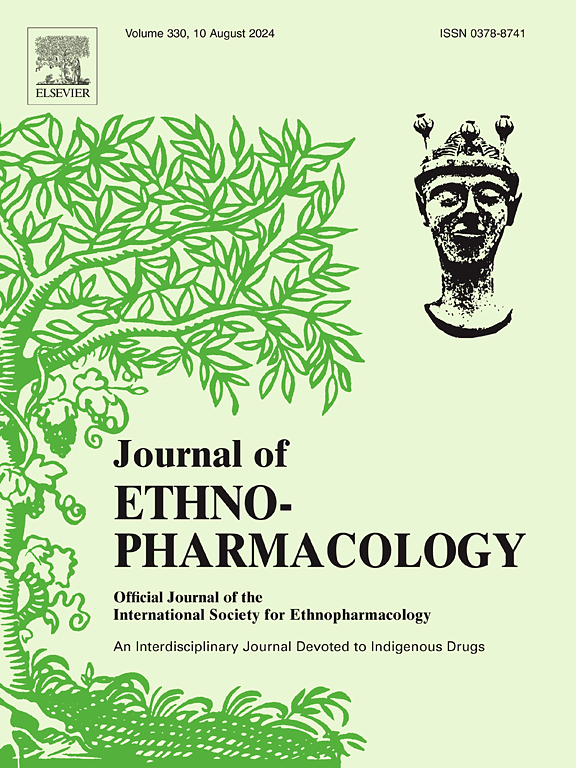amp活化蛋白激酶在溃疡性结肠炎大鼠模型中介导Ceiba speciosa和Ceiba insignis的抗炎和抗氧化作用
IF 4.8
2区 医学
Q1 CHEMISTRY, MEDICINAL
引用次数: 0
摘要
民族药理学相关性:木棉属(malvacae)包括200种,自然生长在世界各地的热带和亚热带地区,如西非,南亚,墨西哥,中美洲,南美洲,巴哈马和加勒比地区。竹叶(a . st . hill)Ravenna (CS)和Ceiba insignis (Kunth) P.E.Gibbs & Semir (CI)传统上用于治疗炎症性疾病,如溃疡、关节炎和风湿病。研究目的:本研究旨在对荆芥和荆芥叶甲醇提取物进行表征,并评价其对醋酸致溃疡性结肠炎大鼠模型的抗氧化和抗炎作用。材料与方法:采用液相色谱-质谱联用技术(LC-MS)对CS和CI进行化学分析。采用醋酸诱导溃疡性结肠炎模型。观察组织学检查及炎症和氧化应激标志物水平。利用Discovery studio软件在5-LOX和COX-2的活性位点进行对接研究。结果:共鉴定出30种植物成分,以黄酮类和酚酸为主。两种提取物在低剂量和高剂量(200和400 mg/kg p.o)下均表现出显著的抗氧化和抗炎活性,但CI的活性优于CS。CI显示出明显的抗氧化活性,丙二醛水平降低(41.3%和48.6%),过氧化氢酶显著升高2.6倍和3.1倍,谷胱甘肽显著升高2.6倍和3.4倍。抗炎活性主要表现为COX-2(33.0 ~ 52.0%)、TNF-α(47.4 ~ 63.4%)的降低。低剂量时,CI显著提高AMPK和NF-kB水平1.4倍和4.5倍,高剂量时AMPK水平提高6.7倍。对接实验表明,氯维胺在5-LOX和COX-2活性位点的结合能(ΔG = -35.8 kcal/mol和-36.6 kcal/mol)内的拟合效果最佳。结论:CS和CI均表现出较强的抗炎活性,进一步巩固了其在溃疡性结肠炎大鼠模型中的传统重要性,但CI表现出更强的效力。本文章由计算机程序翻译,如有差异,请以英文原文为准。
AMP-Activated Protein Kinase mediates the anti-inflammatory and antioxidant effects of Ceiba speciosa and Ceiba insignis in a rat model of ulcerative colitis
Ethnopharmacological relevance
Genus Ceiba, (Malvaceae) encompasses 200 species that naturally thrive in tropical and subtropical regions worldwide as West Africa, South Asiam Mexico, Central America, South America, the Bahamas and the Caribbean. Ceiba speciosa (A.St.-Hil.) Ravenna (CS) and Ceiba insignis (Kunth) P.E.Gibbs & Semir (CI) were traditionally used for treatment of inflammatory disorders as ulcer, arthritis and rheumatism.
Aim of the study
The study aimed to characterize CS and CI leaves methanol extracts and to evaluate their antioxidant and anti-inflammatory effect on acetic acid induced ulcerative colitis in rat model.
Materials and methods
Chemical profiling of CS and CI was done by liquid chromatography combined with mass spectrometry (LC-MS). In vivo ulcerative colitis model was induced by acetic acid. Histological examination and levels of inflammatory and oxidative stress markers were investigated. Docking studies were performed in the active sites of 5-LOX and COX-2 using Discovery studio software.
Results
Thirty phytoconstituents, mostly flavonoids and phenolic acids were characterized in CS and CI. Both extracts showed significant antioxidant and anti-inflammatory activity at the low and high doses (200 and 400 mg/kg p.o.) but CI exhibited better activity than CS. CI showed pronounced antioxidant activity evidenced by reduction in malonaldehyde levels (41.3 % and 48.6 %) with significant elevation in catalase by 2.6 and 3.1 folds and glutathione by 2.6 and 3.4 folds respectively. The anti-inflammatory activity reflected in the reduction of COX-2 levels (33.0–52.0 %), TNF-α (47.4–63.4 %) respectively. As for AMPK and NF-kB levels at the low dose, CI increased their levels significantly by 1.4 and 4.5 folds while at the high dose AMPK levels elevated by 6.7 folds. The docking experiment showed that clovamide had the best fitting within the 5-LOX and COX-2 active sites with binding energy (ΔG = −35.8 and −36.6 kcal/mol) respectively.
Conclusion
Both CS and CI showed potent anti-inflammatory activity that further consolidates its traditional importance in ulcerative colitis rat models, but CI showed more potency.
求助全文
通过发布文献求助,成功后即可免费获取论文全文。
去求助
来源期刊

Journal of ethnopharmacology
医学-全科医学与补充医学
CiteScore
10.30
自引率
5.60%
发文量
967
审稿时长
77 days
期刊介绍:
The Journal of Ethnopharmacology is dedicated to the exchange of information and understandings about people''s use of plants, fungi, animals, microorganisms and minerals and their biological and pharmacological effects based on the principles established through international conventions. Early people confronted with illness and disease, discovered a wealth of useful therapeutic agents in the plant and animal kingdoms. The empirical knowledge of these medicinal substances and their toxic potential was passed on by oral tradition and sometimes recorded in herbals and other texts on materia medica. Many valuable drugs of today (e.g., atropine, ephedrine, tubocurarine, digoxin, reserpine) came into use through the study of indigenous remedies. Chemists continue to use plant-derived drugs (e.g., morphine, taxol, physostigmine, quinidine, emetine) as prototypes in their attempts to develop more effective and less toxic medicinals.
 求助内容:
求助内容: 应助结果提醒方式:
应助结果提醒方式:


